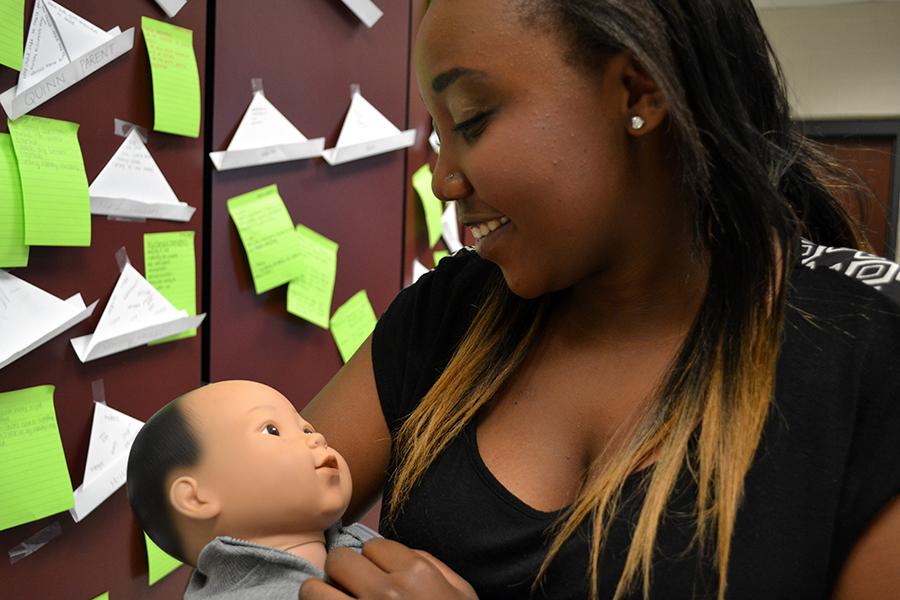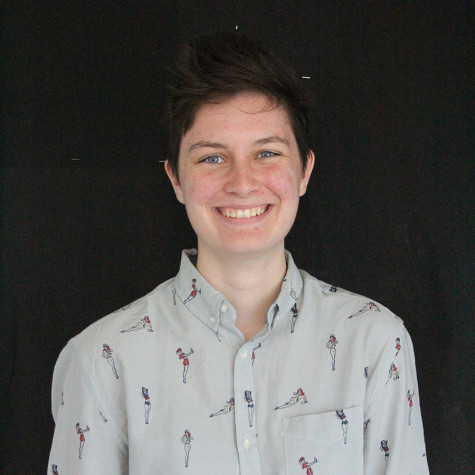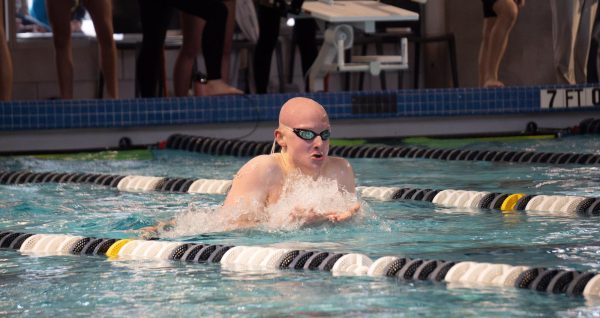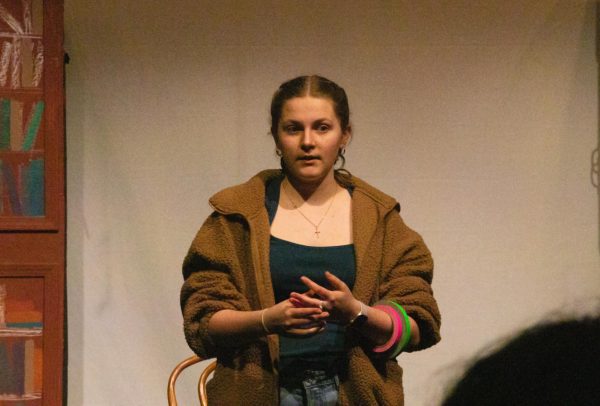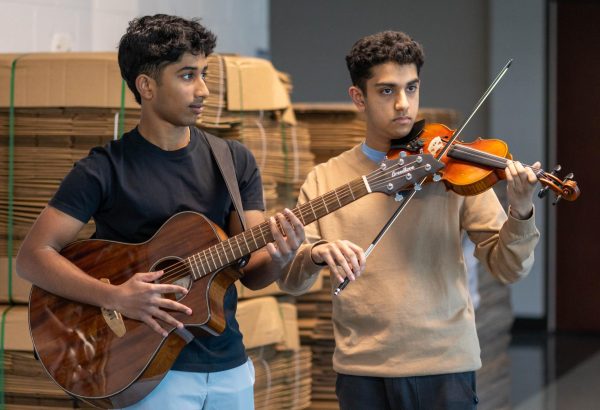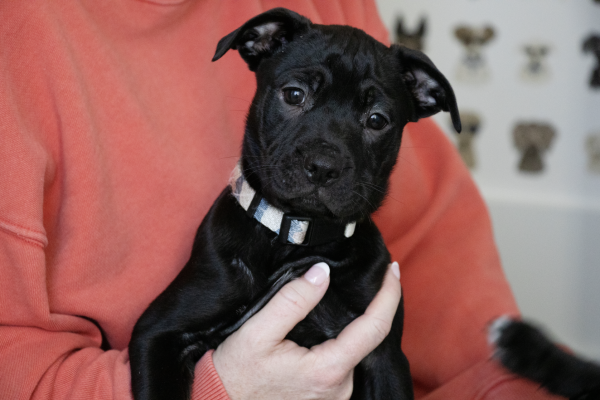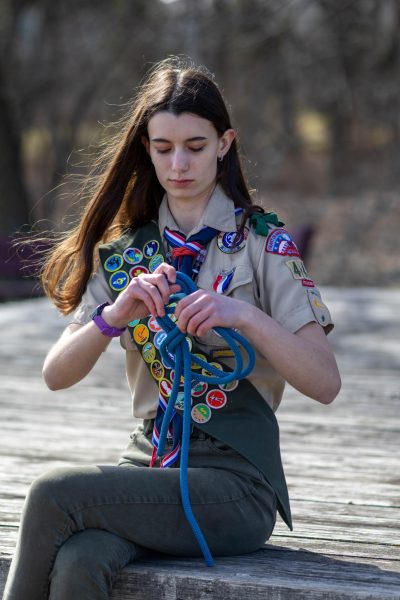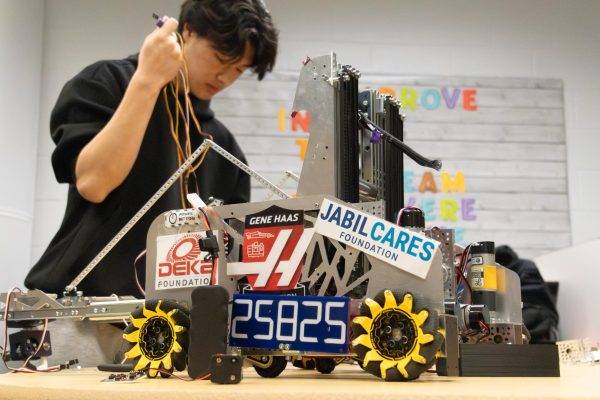Oh, Baby!
The child development class has replaced their electronic babies with more advanced and high-tech versions.
Sophomore Cynthia Karanja cuddles an electronic baby in her Childhood Development class.
The unmistakable wails of the electronic babies from the child development class have been heard all around the school. Now, these simulators have been upgraded to more technologically advanced versions that the class currently uses. Child Development and Family and Consumer Sciences teacher Cecilia Jaggard said that her students have been eager to take care of the new babies and take on the responsibilities that come with them.
“The students are excited to see [the new babies] and work with them,” Jaggard said. “They take out the computerized babies, which are called infant simulators, for 48 hours. They are like a single parent with a child and they have to take care of the baby.”
The babies have sensors that register if the student is handling it incorrectly, for example, if the baby isn’t fed, diapered, rocked, burped or other things. These sensors differ from last year in what they can detect.
“The new computerized babies have sensors in the baby carriers,” Jaggard said. “They can tell how long they have been at a certain temperature, so you can’t just leave your baby in the trunk of your car and go watch a movie because it’ll tell on you. It also registers rough handling, shaken baby syndrome, and if the head of the baby is not supported. If you handle the baby real roughly or you don’t tend the baby, it’ll scream for a while and then it will shut down.”
When the baby starts to make noises, the mother or father puts their sensor near the baby, registering that the baby will be tended to. After that, the student must decipher what the baby’s needs are.
“The student figures out if it needs to be diapered, if it needs to be fed,” Jaggard said. “They will hold a bottle to its mouth, and if that’s the right answer, the baby starts making swallowing noises. If that doesn’t work, the baby continues to cry. Then they will try to change the diaper. If that doesn’t work, then they have to try to rock the child. After they feed the child, they need to burp the child or the child will continue to cry. The child cries if they’re not getting the right care.”
Senior Riley Obetz, who took the class last year with the old babies, played tennis at the same time she did the baby project, which she said was no easy task.
“When I was at a match and the baby would cry, I would have to run over to the gate in between points and swipe [the sensor] and then my mom would have to take care of it,” Obetz said. “It was a pain.”
Senior Molly Gay, who is currently taking the child development class with the new baby simulators, has had conflicts with the baby because of her work schedule.
“It was so hard [to work and have the baby],” Gay said. “I had to redo the assignment because work conflicted with it so much.”
Jaggard said that taking care of the babies takes some getting used to for the students.
“The students have to get the hang of it,” Jaggard said. “At first, they are kind of scared when the baby starts reacting, but they know that they take their sensor and try this and try this and other students have helped them, saying, ‘Try this, do this!’ and that helps get them in shape.”
Taking care of the baby was a difficult and strenuous experience because of how much time and attention the baby requires, both girls said.
“It woke me up in the middle of the night a lot,” Obetz said. “It was really hard to do homework because it would cry periodically. When I would get into the shower and I heard the baby cry, I would have to get out immediately because I had to get to it within two minutes of it crying or it would dock me points.”
Gay said taking care of the baby required a lot of work and was a lot more difficult than she had expected it to be. The new sensors required extreme focus and emphasized the time a real mother spends with her child.
“When you take care of the new babies, you have to give it your undivided attention; you have to keep up with it,” Gay said. “It’s like taking care of a real baby. If you’re not prepared to stay up all night and rearrange your schedule around it, it’s super hard to keep up with it and give it the proper care that it needs.”
Taking care of the babies has helped the students realize that it’s better for them to wait to have kids, Jaggard said.
“The students say that they want to wait until they get an education and someone that loves them to help them with their children,” Jaggard said. “They want to have kids, they just see the practicality of putting it off while they’re teenagers and have other things to do. It gives them some idea of what it’s like to be a single teen parent.”
Obetz said that her experience with taking care of the baby will help her better parent her children when she is a mother because of what it has taught her.
“It was definitely a learning experience…I knew how hard parenting was and how having children is very hard, but I didn’t know the extent of how tired I would be and how difficult it really was, especially acting as a single parent in this situation,” Obetz said.
Regardless of which version of the baby students have used, it is agreed that taking care of the baby is a valuable learning experience. However, with the improved technology, the students will be able to simulate a more real-life situation.

Senior Laney Breidenthal was a writer and reporter for one year, the features editor for one year and is now the print editor for The Express. She enjoys reading, writing, spending time with family and friends, eating copious amounts of Panera's broccoli cheddar soup, learning about European history, listening to music, the color yellow, the Royals, pasta and seafood. Her favorite part of newspaper is doing what she loves every single day with some of her favorite people. She has fun meeting new people and the time and learning what makes them who they are.


